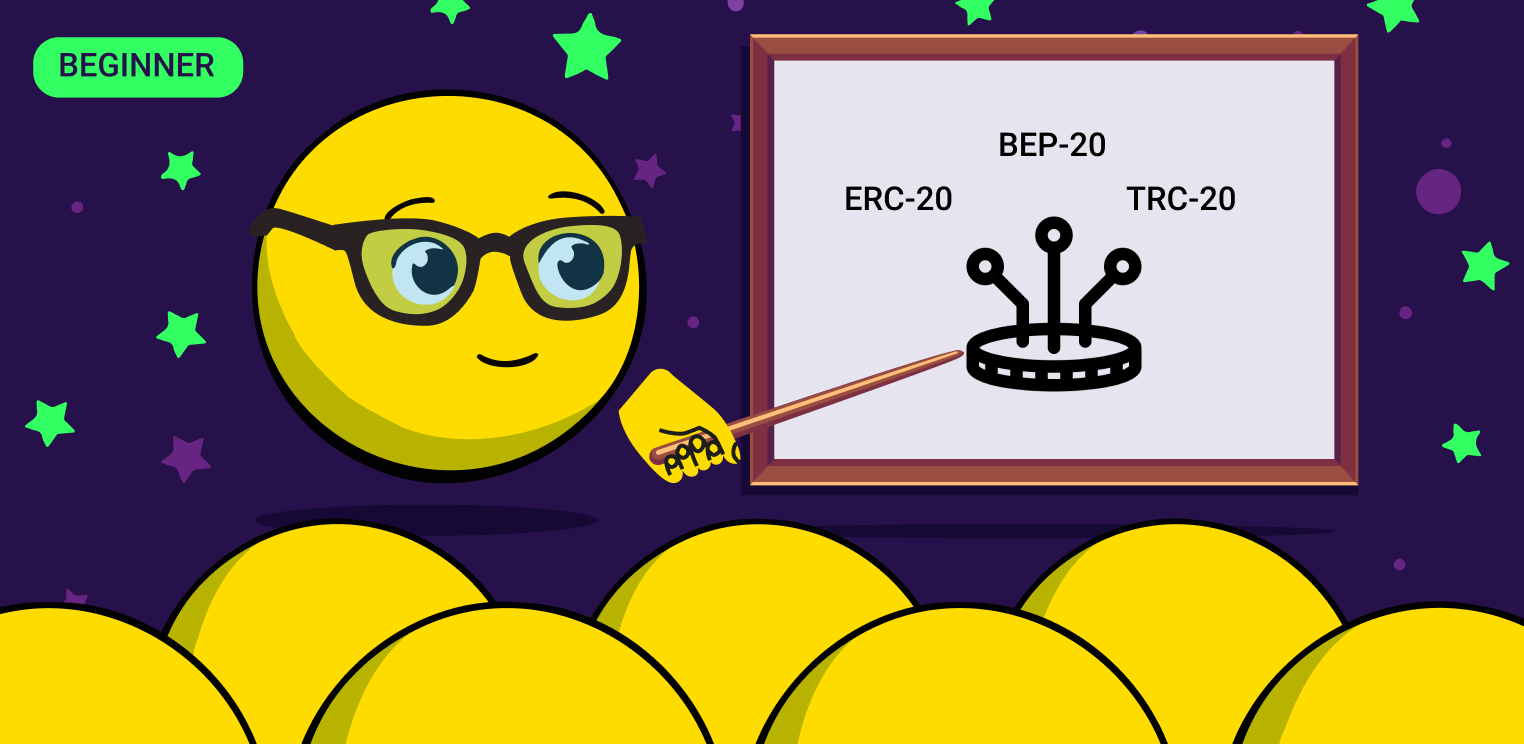
Crypto token standards are sets of basic rules that a token must comply with to be able to function on the network.
At the moment there exist a wide variety of cryptocurrencies, which may seem very different at first glance. However, all of them follow one of the few standards that allow them to function within a certain blockchain. An understanding of the main principles of these standards may be extremely helpful to recognize how tokens function.
ERC-20 Tokens
The ERC-20 standard was proposed in 2015 by Fabian Vogelsteller. The initial idea was to provide an API within smart contracts.
Features and Benefits
The main special feature of this standard is that it is created for fungible tokens, which means that each ERC-20 token has exactly the same functionality, type, and value.
The ERC-20 standard token must comply with several points:
- such tokens can be transferred from one account to another;
- a current token balance on a certain account;
- total supply of a certain token on the network;
- transfers of a certain number of tokens to a specified address;
- withdrawal of a certain number of tokens from a specified account.
Even though ERC-20 has been a leading standard for a long time, it has a number of disadvantages:
- A lack of flexibility. This comes along with the stability, which means that ERC-20 tokens’ opportunities are very limited and can’t be used for more complex tasks.
- Security issues. Some security vulnerabilities are recognized on the Ethereum network, and all of them are transferred to every token created on this network.
- Gas fees. Gas fees are required for every transaction on the network and may cost quite a lot, which can become a big concern.
Popular Use Cases and Examples
All the tokens issued on the Ethereum blockchain have the ERC-20 standard. For example, Tether (USDT), Binance (BNB), Uniswap (UNI), Aave (AAVE).
Other ERC Tokens
Since the ERC-20 standard is not perfect, there are a lot of attempts to improve it, which resulted in the development of other standards.
ERC-721
ERC-721 is a standard that is made for non-fungible tokens on the Ethereum blockchain. It was introduced at the end of 2020. Since NFTs are unique they bring more opportunities to token’s functionality.
For example, Mainnet Alpha, Arbitrum on Makx, AlShip OG Collection.
ERC-1155
ERC-1155 is a multi-token standard, which has the functionality of ERC-20 and ERC-721. However, in addition, it has other features:
- allows to transfer of multiple assets in a single move;
- gets the balances of multiple assets;
- approves all tokens to a certain address;
- supports NFTs;
- safe transfer.
BEP-20 Tokens (Binance Smart Chain)
Binance Smart Chain was introduced in 2020. It is the second network created by Binance. The first one was called the Binance Chain (BC). Instead of improving the existing chain, developers decided to create a brand new one.
Key Features and Comparison to ERC-20
ERC-20 and BEP-20 tokens have a lot in common, however, there are significant differences between them. For example, the transaction speed for BEP-20 is faster. It is about 3 seconds, while for ERC-20 it can reach 15 seconds. In general, BEP-20 can handle about 1,400 transactions/sec. In comparison, the ERC-20 standard can proceed with 20 transactions per second. BEP-20 standard tokens were also capable of minimizing gas fees.
Both standards utilize the same address format and they are compatible. This gives developers opportunities to create for both standards.
At the moment BEP-20 is a popular token standard among developers due to its low fees, scalability, and compatibility.
Here are some examples of tokens built on the Binance Smart Chain: BNB, BUSD, PancakeSwap, C.R.E.A.M.
BEP-2 Tokens (Binance Smart Chain)
BEP-2 is another token standard that is utilized on the Binance Chain. BEP-2 tokens are native to the Binance Chain and are interoperable with BEP-20 tokens on the Binance Smart Chain.
However, unlike BEP-20, which is EVM-compatible, BEP-2 tokens are built for the Binance Chain's native blockchain. BEP-2 tokens are commonly used for transactions, trading, and as a means of payment within the Binance ecosystem.
Binance Coin (BNB) is the most well-known example of a BEP-2 token, as it serves as the native asset of the Binance Chain.
TRC-20 Tokens (TRON Network)
Tron is a decentralized digital, smart contract platform, its native token is TRX. It was launched in 2017 in Singapore. At first, it was noticed in Asia but later became popular all over the world.
Key Features of TRC-20 Tokens and Comparison to Other Types
TRC-20 and ERC-20 tokens use the same smart contracts design. The main difference between them is the networks they use. Nonetheless, the TRC-20 standard has a number of its own benefits:
- token swapping;
- unlimited access to data;
- transparency;
- low transaction fees;
- high scalability.
The TRC-20 standard gained popularity quite fast and was proclaimed an “Ethereum killer”.
Here are some examples of TRC-20 tokens: Tether (USDT), Trust Wallet Token (TWT), Just (JST), and Echo (ECHO).
Other Token Standards
The token standards mentioned above are not the only ones, but they are the basic ones. The crypto world is a quickly developing area, thus new solutions appear quite often. Sometimes we can see new standards built on the basement of previous ones, such as ERC-777.
However, Ethereum and Binance are not the only possible networks for creating tokens and DApps. Each network has its own standard. For example, for Tezos: TZIP-7, TZIP-12. For NEO: NEP-5, NEP-11, NEP-17.
Interoperability and Token Bridges
Importance of interoperability in the crypto space
Since the amount of token standards is increasing, it is highly important for networks to communicate with each other. This is the only way to create a unified ecosystem, which may have endless development opportunities.
Cross-chain token transfers and bridges
A high demand for interoperability resulted in the creation of cross-chain bridges, technology that allows users to send information from one blockchain to another.
Here are the names of several bridges: Celer cBridge, Cross-Chain Bridge, Multichain, etc.
Each bridge supports a pool of blockchains and tokens.
Examples of interoperability solutions
Bridges are not the only way to ensure interoperability. For example, it is possible to issue a certificate, which contains necessary data and is verifiable across networks. Another way is to create a parachain, a chain that uses sharding. This type of chain can connect via shards. Also, it is possible to make a sidechain. It is almost autonomous from the mainchain and can incorporate different blockchain logic, thus making it possible to connect to apps from different blockchains.
Conclusion
As we can see the crypto world is offering more and more crypto standards. They are changing with the emerging demand for new use cases and with the increasing number of crypto users. Now interoperability seems to be one of the key problems that the crypto community is bound to solve in the near future. The idea of Web 3 made it obvious that without fast and clear communication between different blockchains, it is impossible to create a united ecosystem, which represents a perfect future for the crypto world.

